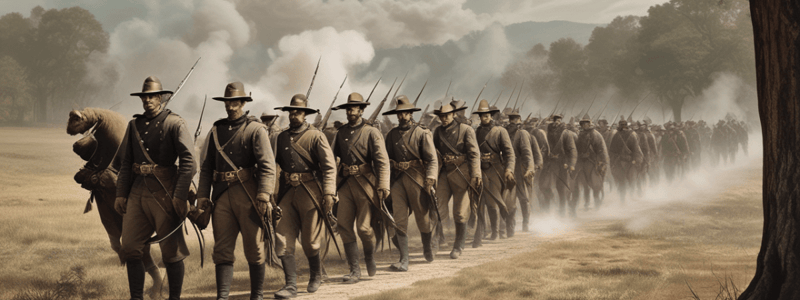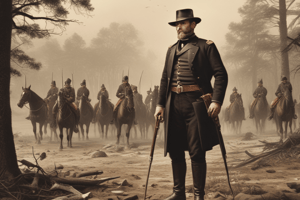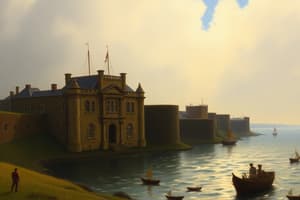Podcast
Questions and Answers
What was the primary military objective of Sherman's March to the Sea?
What was the primary military objective of Sherman's March to the Sea?
- To capture the city of Atlanta
- To take Savannah, Georgia, as a supply base (correct)
- To destroy the civilian population of Georgia
- To advance on Robert E. Lee's Army of Northern Virginia
Why did Sherman propose to 'live off the land' during the March to the Sea?
Why did Sherman propose to 'live off the land' during the March to the Sea?
- To avoid leaving a garrison in Atlanta and to supply his army (correct)
- To slow down his army's advance
- To avoid contact with the Confederate army
- To punish the civilian population of Georgia
What was the significance of Savannah, Georgia, in Sherman's plan?
What was the significance of Savannah, Georgia, in Sherman's plan?
- It was a key city in the Confederate capital
- It was a strategic location for launching a naval attack
- It was a major supply base of ammunition and cotton (correct)
- It was a center of Confederate military operations
What was the underlying philosophy behind Sherman's military strategy?
What was the underlying philosophy behind Sherman's military strategy?
What was the ultimate goal of Sherman's March to the Sea, beyond taking Savannah?
What was the ultimate goal of Sherman's March to the Sea, beyond taking Savannah?
What was General Sherman's instruction to his army regarding foraging for supplies during the march?
What was General Sherman's instruction to his army regarding foraging for supplies during the march?
Why did General Sherman choose to march through the most fertile and agriculturally productive area of Georgia?
Why did General Sherman choose to march through the most fertile and agriculturally productive area of Georgia?
What was the significance of the Battle of Griswoldville?
What was the significance of the Battle of Griswoldville?
What was unique about the destruction of infrastructure during Sherman's March to the Sea?
What was unique about the destruction of infrastructure during Sherman's March to the Sea?
What was the outcome of the siege of Savannah?
What was the outcome of the siege of Savannah?
What was the main objective of Sherman's March to the Sea?
What was the main objective of Sherman's March to the Sea?
What was the result of Sherman's army staying in and around Savannah for one month?
What was the result of Sherman's army staying in and around Savannah for one month?
What was the consequence of Sherman's army appearing in North Carolina?
What was the consequence of Sherman's army appearing in North Carolina?
What was Sherman's intention regarding the civilian population of the Confederacy?
What was Sherman's intention regarding the civilian population of the Confederacy?
What concept is associated with Sherman's March to the Sea?
What concept is associated with Sherman's March to the Sea?
Flashcards are hidden until you start studying
Study Notes
Sherman's March to the Sea
- Proposed by Major General William Tecumseh Sherman in September 1864, after capturing Atlanta, to take Savannah, Georgia, an important Confederate supply base of ammunition and cotton.
- Sherman's army would then turn north to advance on Robert E. Lee's Army of Northern Virginia, currently engaged with General Ulysses S. Grant, and General George Meade's Army of the Potomac at Petersburg, Virginia.
The Controversial Strategy
- Sherman proposed to cut his army loose from the newly occupied Atlanta as a logistical base to supply his operations and supply itself through foraging.
- He would not need to leave a garrison in Atlanta to protect his supply base and supply line.
- Sherman knew that he would bring the horrors of war to the civilian population of Georgia through the destruction and devastation of the land as his army supplied itself with food and forage.
Conducting the War
- Sherman was a proponent of what came to be called "Total War" in the twentieth century.
- He issued General Order 120, which prescribed what he expected from his officers and soldiers.
- Foraging parties, nicknamed "bummers", aimed to keep ten days of food in the supply wagons and three days of forage for the horses.
- No soldier was allowed to enter any dwelling.
- Only the four corps commanders in the army could order the destruction of any mills, cotton-gins, or houses.
The March
- Sherman's 62,000-man army left Atlanta on November 15, 1864, and marched through Georgia, taking 37 days to reach Savannah.
- The march took place through the most fertile and agriculturally productive area of Georgia, as determined by Sherman using the 1860 census numbers.
- The army destroyed Georgia's infrastructure, including bridges, tunnels, and railroad tracks.
- Military engagements were relatively small-scale, with skirmishes occurring almost daily.
The Battle of Savannah
- On December 10, 1864, Sherman's army reached the outskirts of Savannah, defended by 10,000 Confederate troops.
- Sherman sent a letter to General Hardee, stating that he had siege guns that could reach every location in Savannah and controlled every means of entrance and exit.
- Sherman demanded the surrender of Savannah and all fortified positions, offering liberal terms to the inhabitants and garrison.
- Hardee did not surrender, but neither did he fight. Instead, he escaped on a hastily built pontoon bridge over the Savannah River.
The Aftermath
- On December 21, 1864, the mayor of Savannah, Richard Arnold, and some aldermen, approached Sherman with an offer to surrender the city if Sherman would agree to protect the citizens and property of Savannah.
- Sherman accepted and ordered General Geary's XX Corps to occupy the city, providing provisions for the city's residents.
- Sherman's army stayed in and around Savannah for one month before heading north into North Carolina, intending to move into Virginia and combine with Grant's army.
Significance
- Sherman's March to the Sea was intended to demoralize the civilian population of Georgia and make them feel the hard hand of war.
- The march was a significant aspect of the concept of "Total War", where civilians are a military target during war.
- The march shortened the war, as it cut off Robert E. Lee's planned escape route.
- The psychological impact of the march led to an increase in desertions in Robert E. Lee's Army of Northern Virginia.
Studying That Suits You
Use AI to generate personalized quizzes and flashcards to suit your learning preferences.




